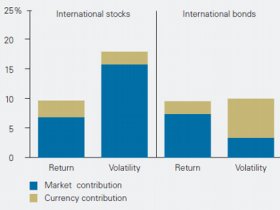
 Vanguard released a fascinating paper this present year entitled . Here is the exec summary:
Vanguard released a fascinating paper this present year entitled . Here is the exec summary:
Executive summary. Traditionally, U.S. investors have attained
diversification of a domestically focused profile mainly through
utilization of worldwide equities. But within the last a decade the worldwide
investable market changed markedly, largely as a result of the growth
and maturation of globe relationship areas with the continuous
globalization of companies and money flow. Overseas bonds today
form over 35% for the world’s investable assets, yet numerous
domestic investors don't have a lot of or no exposure to these securities. Is there
empirical or useful considerations that will justify such property prejudice in
U.S. investors’ profiles?
Generally speaking this report has actually lots of great information. Foreign bonds are the largest investment group in the field, yet tend to be interestingly absent from many U.S. investor’s portfolios. There clearly was much becoming attained through the inclusion of foreign bonds, which we consider one of six important asset classes. The analysis discovers that growing marketplace bonds enhance a portfolio whether or not they tend to be hedged or unhedged. They are all conclusions we agree with wholeheartedly.
There was only 1 point in which I would disagree, maybe not along with their data, however with their particular conclusions. They suggested that investing in hedged foreign bonds resulted in less return but in addition less volatility and that the reduction in volatility had been worth the reduction in return.
Hedging an international relationship financial investment dampens comes back given that fund must buy choices against each currency fluctuation. These options expire since useless in the event that buck moves sideways or declines in price but protect your investment in the event that dollar strengthens up against the foreign exchange.
I might concur that hedging anything against movements into the buck decreases volatility whenever calculated in bucks. But dampening volatility ultimately means dampening return. A return of zero comes with a volatility of zero. Calculating every thing in dollars is sensible only provided that the dollar remains a secure store of value and does not go through the rollercoaster trip regarding the flood of need in 2008 and then the flood of supply last year.
Even in the Vanguard study, the chart reveals their evaluation:
The last 25-plus many years also had been characterized by long-lasting depreciation associated with U.S. buck. This is the reason unhedged worldwide bonds outperformed hedged bonds by 2.4 percentage things annually, normally. Since unhedged bonds heighten portfolio volatility and advise a bearish view on the U.S. buck, the crucial questions then tend to be: Should people anticipate the U.S. buck to stay on a long-term downward trend, and would these types of decline effortlessly counter the larger volatility?
Dropping 2.4 percent of this return yearly in the last 25-plus years is an important loss. It reminds me personally of the best Paul Volker estimate, “You can’t hedge the whole world.” Put simply, the insurance coverage of hedging is much more than I would like to pay.
I utilized Morningstar Principia Pro to consider two-bond funds, PIMCO international Bond (USD-Hedged) Institutional (PFORX) and PIMCO international Bond (Unhedged) Institutional (PFUIX) over the last year together with final five years. Right above the past 12 months the hedged version came back 5.37per cent and unhedged variation came back 13.85% (year ending 5/31/2011). Losing 8.48percent over one-year is of useful go back to give-up for a theoretical decrease in volatility.
The five year comes back had been no much better. PFORX averaged 6.42per cent verse PFUIX’s 9.33percent. (5 years finishing 5/31/2011). Once again, losing 2.91percent of return yearly isn't some thing I would readily conceed. Listed below are those two assets in share cost (which does not feature dividends) in the last five years.









